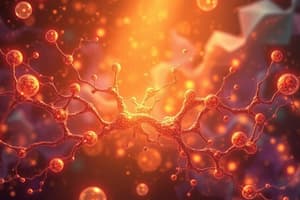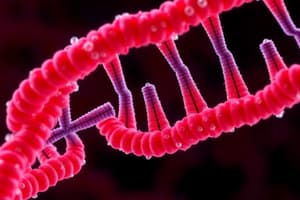Podcast
Questions and Answers
Which type of hormones are derived from amino acids like tyrosine and tryptophan?
Which type of hormones are derived from amino acids like tyrosine and tryptophan?
- Peptide hormones
- Lipid-derived hormones
- Glycoprotein hormones
- AA derivative hormones (correct)
Which of the following is NOT a type of glycoprotein hormone?
Which of the following is NOT a type of glycoprotein hormone?
- Luteinizing Hormone (LH)
- Thyroid Stimulating Hormone (TSH)
- Human Chorionic Gonadotropin (hCG)
- Growth Hormone (correct)
What distinguishes glycoprotein hormones from other protein hormones?
What distinguishes glycoprotein hormones from other protein hormones?
- They contain a carbohydrate (sugar) component. (correct)
- They are only produced in the pancreas.
- They are derived from lipids.
- They consist of a single chain of amino acids.
Which group do eicosanoids belong to within hormone classifications?
Which group do eicosanoids belong to within hormone classifications?
What is the primary source of eicosanoids in the body?
What is the primary source of eicosanoids in the body?
What is the initial step in the synthesis of protein/peptide hormones?
What is the initial step in the synthesis of protein/peptide hormones?
Which of the following statements about steroid hormones is true?
Which of the following statements about steroid hormones is true?
During the process of synthesizing protein/peptide hormones, which structure is primarily involved in translation?
During the process of synthesizing protein/peptide hormones, which structure is primarily involved in translation?
What is the primary function of the Golgi complex in hormone synthesis?
What is the primary function of the Golgi complex in hormone synthesis?
Which statement accurately describes the transport of protein/peptide hormones in the body?
Which statement accurately describes the transport of protein/peptide hormones in the body?
What ensures that steroid hormones are released immediately upon synthesis?
What ensures that steroid hormones are released immediately upon synthesis?
Which of the following structures is NOT involved in the synthesis of protein/peptide hormones?
Which of the following structures is NOT involved in the synthesis of protein/peptide hormones?
What is the primary precursor for the synthesis of steroid hormones?
What is the primary precursor for the synthesis of steroid hormones?
Which process is typically involved in the release of protein/peptide hormones?
Which process is typically involved in the release of protein/peptide hormones?
In the production of protein/peptide hormones, what modification occurs following the formation of a primary RNA transcript?
In the production of protein/peptide hormones, what modification occurs following the formation of a primary RNA transcript?
Flashcards
What are amino acid derived hormones?
What are amino acid derived hormones?
Hormones derived from amino acids, specifically tyrosine and tryptophan. They are modified amino acids that act as signaling molecules in the body.
Give examples of tyrosine-derived hormones.
Give examples of tyrosine-derived hormones.
Examples include thyroid hormones (T3 and T4), dopamine, epinephrine, and norepinephrine. These hormones play critical roles in metabolism, mood, and stress response.
What are peptide hormones?
What are peptide hormones?
These are hormones composed of short chains of amino acids. They typically act as signaling molecules within the body and can have diverse functions.
What are protein hormones?
What are protein hormones?
Signup and view all the flashcards
Explain glycoprotein hormones.
Explain glycoprotein hormones.
Signup and view all the flashcards
What determines hormone function?
What determines hormone function?
Signup and view all the flashcards
Protein/Peptide Hormones: Synthesis
Protein/Peptide Hormones: Synthesis
Signup and view all the flashcards
Protein/Peptide Hormones: Storage
Protein/Peptide Hormones: Storage
Signup and view all the flashcards
Protein/Peptide Hormones: Release
Protein/Peptide Hormones: Release
Signup and view all the flashcards
Steroid Hormones: Synthesis
Steroid Hormones: Synthesis
Signup and view all the flashcards
Steroid Hormones: Storage
Steroid Hormones: Storage
Signup and view all the flashcards
Steroid Hormones: Release
Steroid Hormones: Release
Signup and view all the flashcards
What is the cyclopentanoperhydrophenanthrene nucleus?
What is the cyclopentanoperhydrophenanthrene nucleus?
Signup and view all the flashcards
Cholesterol: Steroid Precursor
Cholesterol: Steroid Precursor
Signup and view all the flashcards
Steroid hormone Synthesis Location
Steroid hormone Synthesis Location
Signup and view all the flashcards
Study Notes
Hormone Classification
- Hormones are classified by their proximity to the site of action (autocrine, paracrine, endocrine, neuroendocrine, pheromones) and chemical structure (proteins/peptides, steroids, amino acid derivatives, eicosinoids).
- Solubility in aqueous media is another important classification; hormones can be hydrophobic or hydrophilic.
Hormone Classification: Chemical Structure: AA Derivatives
- Hormones are derived from tyrosine and tryptophan.
- Examples of hormones derived from tryptophan include: L-tryptophan, 5-Hydroxytryptophan, Serotonin, N-acetylserotonin, and Melatonin.
Hormone Derivatives of Tryptophan
- L-Tryptophan is the precursor to 5-hydroxytryptophan.
- 5-hydroxytryptophan is converted to serotonin by the enzyme 5-hydroxytryptophan decarboxylase.
- Serotonin is converted to N-acetylserotonin by the enzyme serotonin N-acetyltransferase (NAT).
- N-acetylserotonin is converted to melatonin by the enzyme hydroxyindole-O-methyltransferase.
Functions of Melatonin
- Melatonin possesses anti-inflammatory, anti-oxidative, immunomodulatory, cardioprotective, and neuroprotective functions.
- It also plays a role in melanogenesis, metabolism regulation, and fixing sleep dysfunction.
- It also acts as a circadian rhythms modulator.
Hormone Derivatives of Tyrosine
- Tyrosine is a precursor to other hormones.
- Examples include: DOPA, Dopamine, Noradrenaline, and Adrenaline.
- These hormones are derived from each other via enzyme mediated conversions.
Protein or Peptide Hormones
- Protein or peptide hormones can be shorter chain peptides, larger proteins, or glycoproteins.
- Examples include Oxytocin and Growth hormone.
Peptide Hormones
- Oxytocin is a peptide hormone.
- Its structure is a chain of amino acids (Gly, Leu, Pro, Cys, Asp, Glu, Cys, Tyr, Ile).
Protein Hormone
- Growth hormone is a protein hormone
- Its structure is depicted schematically as a circular pattern with different amino acids (e.g. Arg, Tyr, Leu, Asn, Ser, etc)
Glycoprotein Hormones
- Glycoprotein hormones are a family of protein hormones.
- They include alpha and beta subunits.
- The alpha subunit is common
- Specificity resides in the beta subunit.
- Examples include TSH, LH, EPO, hCG, Inhibin.
Lipid Derived Hormones
- Lipid derived hormones are derived from Cholesterol.
- They include steroids like Androgens (Testosterone), Oestrogens (Estradiol), and Progestins (Progesterone).
- The adrenocortical group includes glucocorticoids (Cortisol) and mineralocorticoids (Aldosterone).
Lipid Derived Hormones: Eicosanoids
- Eicosanoids derive from omega-3 or omega-6 fatty acids.
- They include prostaglandins (PGs), thromboxanes, and leukotrienes.
Chemical Structure Determines
- Chemical structure directly influences hormone synthesis, storage, release, transport in body fluids, receptor location, mechanism of action, and degradation.
Hormone Synthesis and Storage : Protein/Peptide Hormones
- Synthesis of protein/peptide hormones takes time.
- Hormones are stored in vesicles.
- These vesicles act as reservoirs for the hormones.
Basic Steps in Making a Protein/Peptide Hormone
- The basic steps involve gene transcription to primary RNA transcript to messenger RNA, to translation, prepeptide/prepropeptide, and post-translational modification for mature (active) peptide hormone, finally secretion.
Synthesis of peptide hormones : steps
- Hormones are synthesized in ribosomes on the rough endoplasmic reticulum (ER), then transported to the Golgi apparatus, where they are processed and packaged into secretory vesicles.
- Hormones are then stored in secretory vesicles within the cell until they are released.
Hormone Synthesis and Storage: Steroid Hormones
- Steroid hormones are derived from cholesterol
- Formed in mitochondria and smooth endoplasmic reticulum.
- Synthesized and released immediately.
- Lipid soluble, thus permeable to membranes.
- Not stored in cells
Steroid Hormones Pathway
- Cholesterol is the precursor for the majority of steroid hormones.
- The transformation follows enzymatic pathways.
- Examples include pathways to testosterone and estradiol, and glucocorticoids and mineralocorticoids.
Steroid transformation in target cells
- Steroid hormones bind to receptors.
- The transformed hormone enters the cytoplasm and subsequently the nucleus.
- The steroid activates specific gene expressions.
Protein/peptide vs steroid-mediated secretion
- Proteins/peptides are synthesized and stored in secretory vesicles, relying on exocytosis for release.
- Steroids are immediately released from the steroid-secreting cells.
Insulin Synthesis
- Insulin is a protein/peptide hormone synthesized in steps from preproinsulin, proinsulin to mature insulin.
Multiple Processing Patterns for Protein Hormones
- Preprohormones are processed into active hormones and other peptides.
- Different hormones may be produced from a single preprohormone structure, as demonstrated by ACTH, glipotropins, beta-endorphin fragments.
Hyperpigmentation
- Images of hyperpigmentation (unusual darkening) are shown.
Studying That Suits You
Use AI to generate personalized quizzes and flashcards to suit your learning preferences.





